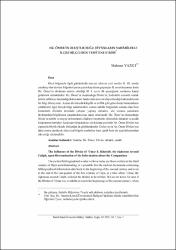| dc.contributor.author | Yazıcı, Mahmut | |
| dc.date.accessioned | 2018-07-19T07:15:43Z | |
| dc.date.available | 2018-07-19T07:15:43Z | |
| dc.date.issued | 2015 | |
| dc.identifier.uri | https://hdl.handle.net/20.500.11776/2800 | |
| dc.description.abstract | Rical bilgisiyle ilgili günümüzde mevcut olan en eski eserler H. III. asırda yazılmış olsa da rical bilgisini içeren yazılı kayıtların geçmişini II. asrın başlarına hatta Hz. Ömer’in dîvânları tedvin ettirdiği H. I. asrın ilk çeyreğinin sonlarına kadar götürmek mümkündür. Hz. Ömer’in oluşturduğu Dîvân’ın, hadislerin sistemli olarak tedvin edilmeye başlandığı ikinci asrın başlarında mevcut olup olmadığı hakkında kesin bir bilgi bilmiyoruz. Ancak dîvânlarda kâtiplik ve arîflik gibi görevlerde bulunanların sahâbîlerle ilgili birçok bilgi nakletmeleri, ayrıca sahâbe bilgisinde uzman olan bazı kimselerin dîvânlar üzerinde çalışma yapmış olmaları, söz konusu şahısların dîvânlardaki bilgilerden yararlandıklarına işaret etmektedir. Hz. Ömer’in oluşturduğu Dîvân’ın tertibi ve atıyye miktarlarına ilişkin rivayetlerle, elimizdeki tabakât ve ensâb kitaplarının tertipleri karşılaştırıldığında ise söz konusu eserlerin Hz. Ömer Dîvânı’nın yapısıyla büyük ölçüde örtüştüğü de görülmektedir. Dolayısıyla Hz. Ömer Dîvânı’nın daha sonra yazılacak olan rical bilgisi eserlerine hem içerik hem de yapı bakımından etki ettiği söylenebilir. | en_US |
| dc.description.abstract | The earliest bibliographical works we have today are those written in the third century of Hijra notwithstanding, it is possible that the earliest documents containing bibliographical information date back to the beginning of the second century and even to the end of the last quarter of the first century of Hijra, at a time when ‘Umar, the righteous second Caliph, ordered the d?w?ns to be written. We do not know for sure if the D?w?n of ‘Umar was available to use in the beginnings of the second century, whenthe traditions started to be compiled systematically. However, the fact that those who have worked in d?w?ns as scribers or experts have also related a lot of information about the Companions on one hand, and that those scholars who were specialists in the bibliographical information on the Companions have also worked on the d?w?ns on the other, shows that the mentioned persons must have benefited from the information in the d?w?ns when they wrote the first biographical dictionaries. When one compares the order of the D?w?n which ’Umar produced and the narrations talking about the amount of the gifts (‘atiyya) with the order of the tabaq?t as well as the ans?b works, they realize that the structure of these works mostly corresponds to that of the D?w?n of ‘Umar. Thus, one can say that the D?w?n of ‘Umar influenced the structures as well as the substances of the bibliographical works, which would be written later on. | en_US |
| dc.language.iso | tur | en_US |
| dc.publisher | Namık Kemal Üniversitesi | en_US |
| dc.rights | info:eu-repo/semantics/openAccess | en_US |
| dc.subject | Companions, ‘Umar b. Khattāb | en_US |
| dc.subject | ‘Umar b. Khattāb | en_US |
| dc.subject | Dīwān, tabaqāt, ansâb | en_US |
| dc.subject | Sahâbe, Hz. Ömer, Dîvân, tabakât, ensâb | en_US |
| dc.title | Hz. Ömer’in Oluşturduğu Dîvânların Sahâbîlerle İlgili Bilgilerin Tespitine Etkisi | en_US |
| dc.type | article | en_US |
| dc.relation.ispartof | Tasavvur / Tekirdağ İlahiyat Dergisi | en_US |
| dc.department | Fakülteler, İlahiyat Fakültesi, Temel İslam Bilimleri Bölümü | en_US |
| dc.authorid | 27510 | en_US |
| dc.identifier.volume | 1 | en_US |
| dc.identifier.issue | 1 | en_US |
| dc.identifier.startpage | 30 | en_US |
| dc.identifier.endpage | 56 | en_US |
| dc.relation.publicationcategory | Makale - Ulusal Hakemli Dergi - Kurum Öğretim Elemanı | en_US |



















